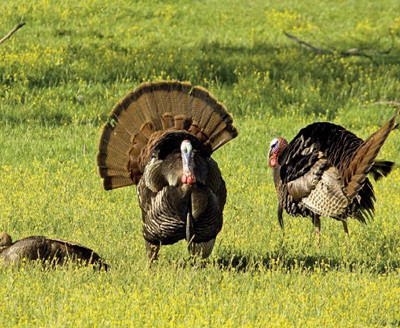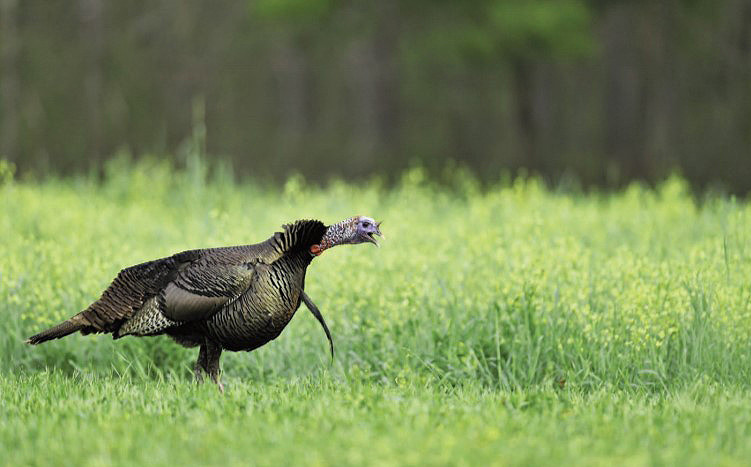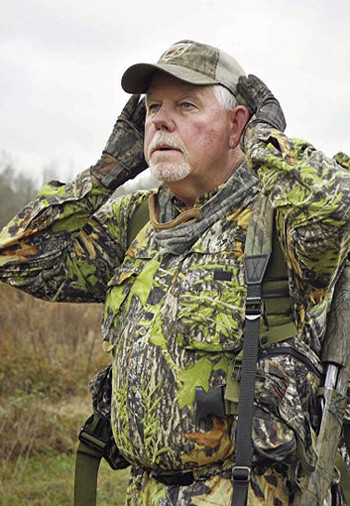When Do Turkeys Fly Down from their roosts? Turkeys typically fly down from their roosts as soon as they can see the ground clearly, usually around sunrise. At flyermedia.net, we provide the insights you need to understand turkey behavior, improving your hunting strategy, by providing an in-depth exploration of avian behavior, hunting techniques, and habitat management. Dive into the world of wild turkey habits with our expert advice, enhancing your ability to locate and successfully hunt these elusive birds.
Table of Contents
1. Understanding Turkey Behavior: The Key to Successful Hunting
2. Deciphering Turkey Sounds: A Hunter’s Guide
3. The Best Time for Turkeys to Fly Down
4. Factors Influencing Fly-Down Time
5. Optimizing Your Listening Position
6. Enhancing Your Hearing Ability
7. Common Sense Strategies for Turkey Hunting
8. Advanced Hunting Techniques
9. Essential Gear for Turkey Hunting
10. Frequently Asked Questions (FAQs) About Turkey Fly-Downs
1. Understanding Turkey Behavior: The Key to Successful Hunting
Understanding the behavior of wild turkeys is fundamental to successful hunting. Learning to interpret their sounds and movements can significantly increase your chances of locating and harvesting these elusive birds. This knowledge will enable you to better predict their actions and strategically position yourself for a successful hunt.
Turkeys exhibit distinct behaviors at different times of the day and year, with their actions influenced by factors such as weather, habitat, and breeding season. Recognizing these patterns can provide valuable insights into their habits and routines. According to the National Wild Turkey Federation, understanding turkey behavior is crucial for effective conservation efforts and sustainable hunting practices.
1.1 The Importance of Observation
Careful observation is a hunter’s best tool. Watching turkeys in their natural habitat allows you to learn their feeding habits, roosting locations, and travel routes. Pay attention to the subtle cues in their behavior, such as the direction they are moving, their interactions with other turkeys, and their responses to changes in the environment.
1.2 Seasonal Patterns
- Spring: During the spring mating season, male turkeys, or gobblers, become more vocal and active as they seek to attract hens. This is the prime time for turkey hunting, as their increased activity makes them easier to locate.
- Summer: In the summer, turkeys focus on feeding and raising their young. They often move into areas with abundant food sources, such as fields and meadows.
- Fall: As fall approaches, turkeys begin to gather in larger flocks and move into wooded areas in search of nuts and seeds. This is a challenging time to hunt, as they become more wary and difficult to approach.
- Winter: During the winter, turkeys seek shelter from the cold and often congregate in areas with dense cover. They rely on stored food reserves and may travel long distances to find sustenance.
 Wild turkeys in their natural habitat
Wild turkeys in their natural habitat
1.3 Habitat Preferences
Turkeys prefer a mix of open fields and wooded areas, providing them with both food and cover. They often roost in trees near the edges of fields or along streams and rivers. Understanding their habitat preferences can help you narrow down your search and focus your efforts in areas where they are most likely to be found.
2. Deciphering Turkey Sounds: A Hunter’s Guide
Learning to decipher the various sounds that turkeys make is an essential skill for any turkey hunter. Each sound conveys a different message, providing valuable information about the turkey’s location, behavior, and intentions.
2.1 The Gobble
The gobble is the most well-known turkey sound, typically made by male turkeys to attract hens during the breeding season. It is a loud, resonant call that can be heard from a considerable distance, making it a valuable tool for locating gobblers in the spring.
2.2 The Yelp
The yelp is a versatile call used by both male and female turkeys to communicate with each other. It can indicate a variety of messages, from a simple greeting to a call for assistance. Hunters often use yelps to mimic the sound of a hen, enticing a gobbler to come closer.
2.3 The Cluck
The cluck is a short, soft sound used by turkeys to maintain contact with each other. It can also indicate alarm or curiosity. Hunters often use clucks to add realism to their calls, making them sound more natural and enticing to turkeys.
2.4 The Putt
The putt is a sharp, abrupt sound used by turkeys to signal danger. It is often accompanied by a quick movement of the head, indicating that the turkey is alert and ready to flee. Hunters should avoid making this sound, as it can scare away turkeys.
2.5 The Purr
The purr is a soft, gentle sound used by turkeys to express contentment or reassurance. It is often heard when turkeys are feeding or resting. Hunters can use purrs to create a sense of calm and security, making turkeys feel more comfortable approaching their location.
2.6 Drumming
Drumming is a low-frequency sound produced by male turkeys as a display of dominance and to attract hens. It is often accompanied by strutting and fanning of the tail feathers. Hunters can listen for drumming to locate gobblers in areas with dense cover.
 Gobbling turkey in a field
Gobbling turkey in a field
2.7 Cackling
Turkey hens often cackle when flying up to or down from the roost. The thump of wings is another distinct sound made by turkeys. In most cases, a gobble in the tree has a different sound than a gobble made on the ground. It is clearer and less muffled.
According to research from the University of Missouri, understanding turkey vocalizations is crucial for effective hunting and conservation efforts. By learning to distinguish between different calls and their meanings, hunters can improve their ability to locate and attract turkeys while minimizing disturbance to their natural behavior.
3. The Best Time for Turkeys to Fly Down
Determining the best time for turkeys to fly down from their roosts is crucial for planning a successful hunting strategy. Several factors influence this behavior, including weather conditions, time of year, and individual turkey habits.
3.1 Sunrise and Daylight
Turkeys typically fly down from their roosts shortly after sunrise, as soon as they can see the ground clearly. The exact time may vary depending on the amount of daylight and the density of the surrounding vegetation.
3.2 Weather Conditions
Weather conditions can significantly affect when turkeys fly down. On clear, sunny mornings, they may fly down earlier than on cloudy or rainy days. Fog can also delay their descent, as it reduces visibility and makes it more difficult for them to navigate.
3.3 Time of Year
The time of year also plays a role in determining when turkeys fly down. During the spring mating season, gobblers may fly down earlier in search of hens. In the fall and winter, they may stay in their roosts longer to conserve energy and avoid predators.
3.4 Individual Habits
Individual turkeys may also have their own unique habits and preferences when it comes to flying down. Some may be more cautious and wait until they feel completely safe, while others may be more eager to get on the ground and begin feeding.
4. Factors Influencing Fly-Down Time
Several key factors can influence when turkeys choose to fly down from their roosts. Understanding these variables can help hunters predict turkey behavior and plan their hunts accordingly.
4.1 Light Levels
Light levels are perhaps the most critical factor in determining fly-down time. Turkeys need sufficient light to see the ground clearly and avoid obstacles, such as branches and underbrush. As a result, they typically wait until after sunrise to descend from their roosts.
4.2 Cloud Cover
Cloud cover can significantly reduce light levels, delaying fly-down time. On cloudy or overcast days, turkeys may remain in their roosts longer, waiting for the clouds to break or for the light to improve.
4.3 Wind Conditions
Strong winds can make it difficult for turkeys to fly safely, causing them to delay their descent. They may wait for the wind to subside before attempting to fly down, or they may choose to remain in their roosts for the entire day if the wind is too strong.
4.4 Precipitation
Rain, snow, or other forms of precipitation can also delay fly-down time. Turkeys may avoid flying in wet conditions, as it can make their feathers heavy and reduce their ability to fly effectively.
4.5 Predator Presence
The presence of predators can also influence when turkeys fly down. If they sense danger nearby, they may remain in their roosts longer, waiting for the threat to pass. Predators such as coyotes, foxes, and owls can pose a significant risk to turkeys, especially when they are on the ground.
According to a study by Pennsylvania State University, turkeys are more likely to delay their fly-down time when they perceive a high risk of predation. This behavior is an adaptive strategy that helps them avoid becoming prey.
5. Optimizing Your Listening Position
To increase your chances of hearing turkeys, it is essential to choose an optimal listening position. This involves considering factors such as terrain, wind direction, and ambient noise levels.
5.1 High Ground
Starting on high ground can significantly improve your ability to hear turkeys. From an elevated position, you can hear over a wider area and detect sounds that might otherwise be obscured by vegetation or terrain features.
5.2 Wind Direction
Pay attention to the wind direction and position yourself upwind of the area you want to listen to. The wind can carry sounds over long distances, making it easier to hear turkeys that are far away.
5.3 Ambient Noise
Avoid listening near sources of ambient noise, such as running water, traffic, or construction sites. These noises can interfere with your ability to hear turkeys and make it more difficult to pinpoint their location.
5.4 Natural Sound Amplifiers
Utilize natural sound amplifiers, such as ridges and valleys, to enhance your hearing ability. These features can help to focus and amplify sounds, making them easier to detect.
5.5 Silence is Key
Minimize any distracting noise. If you are listening with a hunting partner, distance yourself from your partner. This will eliminate any distracting sounds they make or the temptation to talk. It also helps to triangulate the sound’s direction.
6. Enhancing Your Hearing Ability
There are several techniques you can use to enhance your hearing ability and improve your chances of hearing turkeys. These techniques involve both physical and mental strategies that can help you focus your attention and amplify faint sounds.
6.1 Cupping Your Ears
Cupping your hands behind your ears can help to gather more sound into your ear canals. This technique can be particularly effective for detecting faint sounds or pinpointing the direction of a turkey’s call.
6.2 Opening Your Mouth
Opening your mouth slightly while listening can also improve your hearing ability. This action helps to open the ear canal and allows more sound to enter the ear.
6.3 Slowing Your Breathing
Slowing your breathing and taking shallow breaths can reduce the amount of noise generated by your body. This can make it easier to hear faint sounds and concentrate on the task at hand.
6.4 Closing Your Eyes
Closing your eyes can help to eliminate visual distractions and focus your attention on your hearing. This technique can be particularly useful when trying to pinpoint the location of a distant turkey call.
6.5 Mechanical Hearing Devices
Consider using mechanical hearing devices to enhance your hearing ability. Devices such as hearing aids or electronic sound amplifiers can amplify faint sounds and make it easier to hear turkeys that are far away.
7. Common Sense Strategies for Turkey Hunting
In addition to understanding turkey behavior and optimizing your listening position, there are several common-sense strategies that can improve your chances of success when turkey hunting.
7.1 Scout Your Hunting Area
Before the season begins, scout your hunting area to identify potential roosting locations, feeding areas, and travel routes. This will give you a better understanding of turkey behavior in the area and help you plan your hunts accordingly.
7.2 Be Patient
Turkey hunting requires patience and persistence. It may take time to locate a gobbler and entice him to come within shooting range. Be prepared to spend long hours in the woods, and don’t give up easily.
7.3 Use Decoys
Decoys can be an effective tool for attracting turkeys, especially during the spring mating season. Place decoys in a strategic location near your listening position, and use calls to mimic the sound of a hen.
7.4 Practice Your Calling
Proficiency with turkey calls is essential for successful hunting. Practice your calling techniques regularly, and learn to mimic the various sounds that turkeys make.
7.5 Stay Alert
Always stay alert and be aware of your surroundings. Turkeys can appear suddenly and unexpectedly, so it is important to be ready for anything.
 Turkey hunter using a call
Turkey hunter using a call
According to the Quality Deer Management Association, ethical hunting practices are essential for ensuring the long-term sustainability of turkey populations. This includes following all hunting regulations, respecting private property, and avoiding any actions that could harm or disturb wildlife.
8. Advanced Hunting Techniques
For seasoned hunters seeking to elevate their skills, mastering advanced techniques can significantly enhance success rates. These strategies require a deep understanding of turkey behavior and the ability to adapt to changing conditions.
8.1 Reading Sign
Beyond vocalizations, interpreting turkey sign is critical. Tracks, droppings, feathers, and scratchings in the leaves provide clues about turkey activity in the area. Fresh sign indicates recent use, while older sign suggests patterns of movement over time.
8.2 Decoy Setups
Experiment with different decoy setups to mimic natural social dynamics. A single hen decoy can pique the interest of a lone gobbler, while a more elaborate setup with multiple hens and a jake decoy can simulate a flock and incite competition.
8.3 Understanding Topography
Use the terrain to your advantage. Turkeys often follow natural contours, such as ridges and creek bottoms. Setting up in strategic locations along these routes can increase your chances of intercepting a gobbler.
8.4 Adaptability
Be prepared to adjust your tactics based on turkey behavior. If a gobbler is unresponsive to calls, try a different approach. Change your location, vary your calling sequence, or use a different type of call altogether.
8.5 Hunting Pressure
Recognize the impact of hunting pressure on turkey behavior. In areas with high hunting activity, turkeys may become more wary and less responsive to calls. Adjust your tactics accordingly by hunting during off-peak hours or seeking out less-pressured locations.
9. Essential Gear for Turkey Hunting
Having the right gear is essential for a safe and successful turkey hunt. The following items are considered standard equipment for most turkey hunters:
| Gear | Description |
|---|---|
| Shotgun | A 12-gauge or 20-gauge shotgun with a full choke is recommended for turkey hunting. |
| Turkey Loads | Use specialized turkey loads with a high shot density for maximum effectiveness. |
| Camouflage Clothing | Wear camouflage clothing that matches the surrounding vegetation to blend in with your environment. |
| Turkey Calls | Carry a variety of turkey calls, including box calls, pot calls, and mouth calls, to mimic different turkey vocalizations. |
| Decoys | Use turkey decoys to attract gobblers and create a realistic hunting scenario. |
| Binoculars | Binoculars can help you spot turkeys at a distance and assess their behavior. |
| Rangefinder | A rangefinder can help you determine the exact distance to a turkey, ensuring an accurate shot. |
| Hunting Vest | A hunting vest provides convenient storage for your gear and calls. |
| Comfortable Boots | Wear comfortable, waterproof boots that can handle a variety of terrain. |
| First-Aid Kit | Carry a basic first-aid kit for treating minor injuries. |
| Navigation Tools | Use a GPS device or compass to navigate in the woods and avoid getting lost. |
| Knife | A good knife is essential for dressing a turkey and performing other tasks. |
| Insect Repellent | Protect yourself from insect bites with insect repellent. |
| Sunscreen | Protect your skin from the sun with sunscreen. |
| Water and Snacks | Stay hydrated and energized with water and snacks. |
| Hunting License | Ensure you have a valid hunting license and any necessary permits. |
10. Frequently Asked Questions (FAQs) About Turkey Fly-Downs
10.1. How high do turkeys roost?
Turkeys typically roost 12-15 feet above the ground, finding the balance between safety and accessibility.
10.2. Do turkeys fly down at the same time every day?
No, several factors influence their descent, including weather, light levels, and perceived threats.
10.3. Can I call to turkeys while they are still in the roost?
Yes, but with caution. Soft tree yelps or clucks can pique their interest, but aggressive calling might spook them.
10.4. What should I do if a turkey flies down in the opposite direction?
Adapt your strategy. Reposition yourself to intercept its anticipated path or use calls to redirect its movement.
10.5. How can I determine where turkeys are roosting?
Scouting is key. Look for droppings, feathers, and tracks beneath potential roost trees. Also, listen for gobbles at dusk to pinpoint their location.
10.6. Do turkeys always fly down in the same location?
While they may have preferred fly-down spots, turkeys can vary their descent location depending on factors like food availability and predator presence.
10.7. Are young turkeys more predictable in their fly-down behavior?
Yes, younger turkeys often follow the lead of adult hens, making their behavior more predictable compared to mature gobblers.
10.8. How does hunting pressure affect fly-down behavior?
High hunting pressure can make turkeys more cautious and less predictable. They may fly down later or in less accessible locations.
10.9. Can I use decoys to influence where turkeys fly down?
Yes, placing decoys in a desired fly-down location can entice turkeys to land nearby, especially during the breeding season.
10.10. What role do weather patterns play in predicting when turkeys fly down from roosts?
Weather patterns can significantly affect turkey fly-down behavior, particularly in relation to temperature, wind, and precipitation. In cold weather, turkeys may delay their descent to conserve energy and avoid exposure.
Eager to learn more about wild turkey habits, hunting techniques, and habitat management? Visit flyermedia.net today to explore a wealth of information designed to enhance your outdoor experiences. Whether you’re a seasoned hunter or a curious beginner, flyermedia.net offers the resources you need to deepen your understanding of the natural world.
Address: 600 S Clyde Morris Blvd, Daytona Beach, FL 32114, United States
Phone: +1 (386) 226-6000
Website: flyermedia.net

